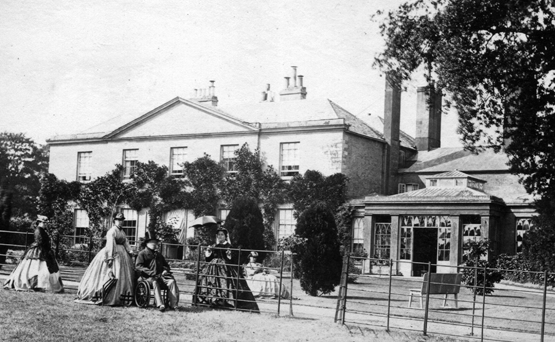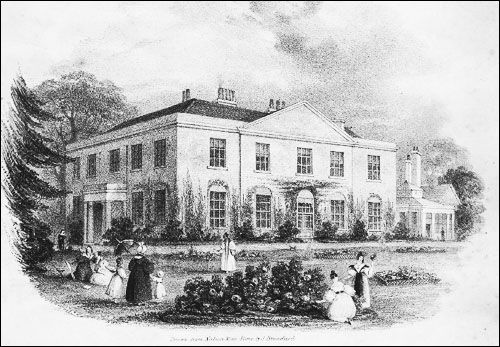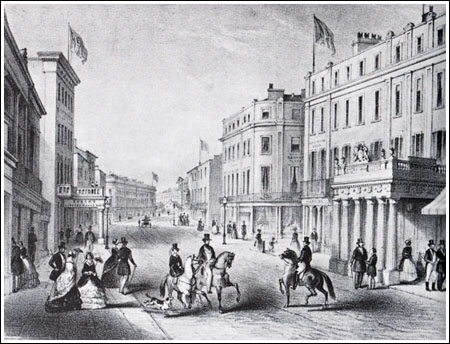
Home
Privacy, Terms & Conditions
Occasional Papers
Ancient Mysteries
BOOKSHOP
Epsom and Ewell Waters
Archives/Reviews
Awards Gallery
Destiny
Malvern Waters and Malverns Worldwide
Somerville Diaries
Grotto News
Grotto Essays
Grotto.DirectoryThe transcription and interpretation of Lady Somervilles Diaries

INTRODUCTION
The original Lady Somerville's diaries were acquired from the book trade in the latter part of the 20th century. Investigation discovered that they had originated from the former library of Matven Hall in Northumberland, England. Along with the diaries, the original Somerville family contemporary photo albums were also discovered and many of the pictures reproduced on this web site emanate from this wonderful archive.
The diaries record the Somerville family holidays in the 1850s. The railways were a new development and Lord and Lady Somerville used this as an opportunity to take their five children together with 5 or more servants to places of interest and relaxation. This involved hiring a complete railway carriage for the family, servants and baggage.
The Somervilles at Newbold Comyn, their home in Leamington Spa.
Written in Lady Somerville's distinct hand, the diaries record the detail of the holidays which lasted for about three months in the summers of the 1850s. This was pioneering a new style of tourism at a time when Queen Victoria ruled a substantial British Empire. The locations of the holidays were for the first time ever, within a days travel of Leamington Spa where the family normally resided. The activities of this somewhat elite family were then diarised for posterity. Fortunately the diaries have survived and subsequent transcription and interpretation enables them not only to be read and enjoyed for their own sake; they also provide a written record of leisure in the changing landscape of an advancing industrialised society.
To access the transcripts click the panels below which give details of date and location. Each annual diary also has an informative introduction. The diary texts detail the specific day when each entry was written and the page number of each individual text book. Footnotes, that are numbered, clarify and add to various comments in the diaries. Introductions and informative notes are of more recent origin and prepared at the time of transcription of Lady Somerville's original text. 








Pre 1850s Background to the Somerville Family.
As a result of research by Dr. Sally-Anne Shearn at the Borthwick Institute in York we are able to secure insights and background details of Lady Somerville and her family. Lady Somerville was formerly Frances (Fanny) Hayman. Fanny married Kenelm Somerville in 1833 and they subsequently had seven offspring over the following 12 years. Lifelong friend Henrietta Crewe was born 30 March 1808, the eldest child of army officer John, 2nd Baron Crewe, and his wife Henrietta Maria Anne Walker-Hungerford. Henrietta’s and her sister Annabel’s correspondence dated between 1829 and 1851 is archived at the Borthwick Institute and yields interesting background information about Fanny and the Somerville family.
We find that Henrietta and Fanny Hayman were childhood friends and their friendship appears to have continued for the rest of their lives. Henrietta visits Fanny at Newbold Comyn regularly, writing about Fanny and her children (and her husband, who Henrietta describes rather unfortunately as a 'non-entity' who is thankfully 'inoffensive and silent'!). In one letter, Henrietta is staying at Leamington Spa for her health and taking her knitting with her to Fanny's house most mornings to sit with her in the conservatory. Henrietta becomes a Roman Catholic in the early 1830s and there are a few amusing mentions of Fanny showing her support when Henrietta visits by tacking up a picture of some nuns over the fireplace in Henrietta's room, or a picture of a cat for 'Cat-holic' instead. Henrietta is evidently very fond of Fanny and they seem to maintain a regular contact.
The first insight however comes from a different source. In 2019 Mavis E and Peter Smith published “Letters from Ellen Tollet to Annabel Crewe.” In a letter dated 17 August 1833 it discusses what appears to be a mutual friend Fanny Hayman soon to be Mrs Somerville. "We had a letter from Henrietta the other day. I do hope she will come to England. She tells us of Fanny Hayman’s intended marriage. I hope it will be a happy one. Charles knows Captain Somerville – says he is a very nice man. There is a great disparity between them – 20 years at least, but still that does not matter much. Indeed, I think the happiest marriages are often this way."
Also mentioned is the Rev. William Somerville (1789 -1857) married Charlotte Bagot in 1830, sister of “Black Drawing Man”. It notes that Miss Hayman was low earlier, previous love passages were suspected! She will be much better off comfortably married. From this we can conclude that Kenelm offered a more stable future for Francis (Fanny) Hayman than earlier relationships.
Returning to Henrietta and sister Annabel’s letters, number 395 to Annabel, dated September 23 1833, confirms that Fanny Hayman was no more. She was now Mrs Sommerville and that her honeymoon was spent touring Tunbridge, Hastings, Southampton etc. then back to Leamington. There were apparently few tears at the wedding and there was a pretty breakfast afterwards at Mrs Ravenscrofts’. This was followed by donning a travelling dress and a brisk drive to Tunbridge Wells.
Some eight years later letter 145 dated 1841, announces that Henrietta has arrived at Newbold Comyn in Leamington, home of the Somerville family. She arrived by train and confirmed that it was without incident, she had not been buried under a tunnel or precipitated down an embankment. These were obviously concerns for early railway travellers. 
Newbold Comyn - demolished in 1964.
Henrietta confirms that Fanny Somerville is looking well and engaging as ever. She describes the house as very pretty in a shady grove by the river in the countryside, albeit only three quarters of a mile out of Leamington. It is a large grey house covered in magnolias, Berkshire roses and beautiful creepers that grow to the top of the building. It is surrounded by lofty trees perhaps a little too near the house. The pretty conservatory opens onto the dining room. There are two spare rooms and they have a dressing room. Also, there is the most spacious nursery/schoolroom; a nice enjoyable house.
Lord Somerville was present during Henrietta’s visit and she describes him as an extraordinary person, a complete non-entity without being an idiot. She sees him as unique and very ugly and not at all aristocratic looking. He is inoffensive and silent but she finds the children very nice. There are three dear little girls, 6, 5 & 4 - Louisa, Emily & Mary, who are called Molly & Polly & Pill and half a hundred things besides. One is like Fanny, and very pretty. Of the two sons, Hugo is 2 years old and Freddy not quite one. A 6th child is expected in November! The little boys at present are the least attractive, tho’ Hugo or Gogo, is an immense pet, and hardly ever out of his father’s arms. They have all learnt to speak French & English together. They have a French nanny called Rosetta of whom they are exceedingly fond and little Emily at 5 yrs. old, reads French & English. Dear Fanny seemed exceedingly happy, with everything this world can give to make and keep her so. Henrietta chose to remain tolerably quiet saying merely that this was not the time for Leamington visiting, recalling painful recollections the last time she was there in January.
The visit appears to have gone sour and when Major Bisshopp and family arrived the following day, this enabled Henrietta to escape. Fanny had wanted to drive to Princethorpe with Henrietta where there is a convent. She queried Fanny’s motives for visiting strange nuns and the trip appears to have been abandoned.
Bath Street Leamington Spa in the 1840s.
In November 1841, Henrietta, in letter 147 to her sister Annabel, once again mentions the Somervilles. Having heard from Captain Somerville (Kenelm), she forwards the information that Fanny has had a fourth little girl. Both are doing well. She hopes the child will be like Mary the 3rd child; beautiful with deep blue eyes and a musical laugh.
Two years pass and in December 1843 there is a brief mention of the Somervilles in letter 253 from Henrietta to Annabel. Henrietta, refers to herself as Blunderbuss and Fanny visited her yesterday on the way to Northamptonshire for a few days. Apparently, Henrietta had failed to keep a luncheon appointment with Fanny owing to rain although she often made morning visits with her knitting. She then comments favourably on the chrysanthemums in the Somerville conservatory, due to be replaced with camelia japonica and bulbs etc. From the text of the letter it is apparent that Henrietta is indulging in warm shower baths at Leamington which was a spa of great reputation at the time. Taken for health reasons, she describes being showered by water while wearing what she describes as a witch’s hat. Later in a letter dated May 1850 from Charlotte Williams Wynn to Annabel at Somerville House, Tunbridge Wells, Lady Fanny also takes a hot air bath which a new doctor prescribed.
As time progresses a further insight is given by a letter 387 in 1845. Fanny Somerville has been to Boulogne and complained to Henrietta about the bleakness of the climate there, especially around the port which hindered travel by those susceptible to the cold north winds. Henrietta recalls a recent visit to Leamington in the letter where Fanny’s carriage and separate luggage cart awaited her, presumably at the station. The Grays, formerly Miss Somerville (Kenelm’s sister?) visited the same day and all appears to have gone well. The attractive conservatory at Newbold Comyn is again commented on, now with a lofty orange tree. Fanny was pretty and merry as usual. The children had all grown in proportion and Mary was prettier than ever with blue eyes and a distinctive shade about the lower and upper part of the eyes, peculiar but beautiful. Little Ju as they call the last child was a little dumpling with long red hair and natural curls. The new governess appeared charming and is described as like the black-bird with good figure and black hair. Blackbird is the nickname for a distant Crewe relative, Anne Symons, the wife of Major William John Symons of Plymouth. Henrietta decided to depart on the Thursday in spite of Fanny inviting her to stay longer. Apparently, Fanny had stuck a large print of Pio [Nono] over her chimney piece and the children were eagerly busy putting up the Pope in Screwy’s room! These appear to be a gentle teasing of Catholic religious beliefs: Pope Pius IX sometimes called "Pio Nono", which is a pun on Pio Nove ("Pius the Ninth") but means "Pius Grandpa" or some might say, "Pius Poppy".
Crimean Cannons
During the 1850s the Crimean War was a major consideration for the British and French. Numerous references are made of this conflict with Russia in the above diaries. After the war, Russian cannon were shipped to England and subsequently distributed throughout the British Empire as War Memorials to those communities that lost loved ones in the war. Some of these cannons survive. To lean more click the cannon below and review our international database of such memorials.
 Dr Bruce Osborne – Chairman Spas Research Fellowship.
Dr Bruce Osborne – Chairman Spas Research Fellowship.
We welcome your comments and observations on the Somerville Diaries. Contact us by emailing bruce.e.osborne@gmail.com
The diary transcriptions and interpretation is the intellectual property and copyright of Dr B E Osborne/SRF and may not be copied or reproduced without permission. All rights reserved.